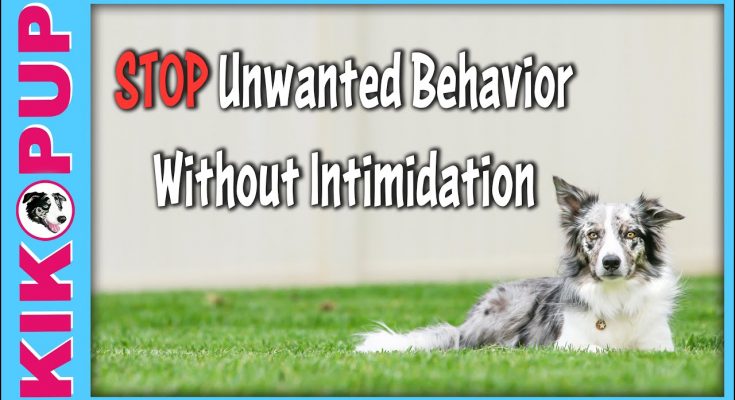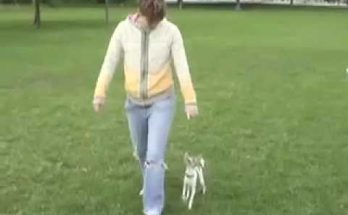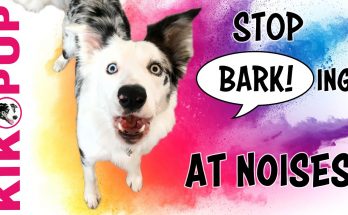How to interrupt your dog in TEN WAYS from doing undesirable behavior without having to use physical or psychological intimidation.
Is saying “no” “eh-eh” or pushing on your dog’s rear to get them to sit cruel or inhumane? No. Of course it’s not. But is it in line with the idea of training by reinforcing behavior. No. It is not. When you start adding in physical or psychological intimidation into your training, even the mildest, you change a simple picture into a very complex one. It is no longer easy to tell why an animal isn’t performing a specific behavior. And by mixing intimidation and reinforcers, you can water down the reinforcement value of your reinforcers causing you to have to turn to harsher and more frequent intimidation… because the “reinforcement is not working”. Punishment for incorrect behavior implies that the animal did something wrong rather than the training plan being badly thought out, so if you didn’t break the steps up correctly for the dog to learn, the dog is punished rather than the trainer.
The side effects of mixing physical and psychological intimidation into training is that you water down the reinforcers you use in the process, making them not as powerful. This makes it difficult to work with your dog when you are competing with other reinforcing things in the environment as the dog can seem like he doesn’t really want to be around you or what you have to offer and prefers the other things over you. And it can seem like your dog is “blowing you off”, being stubborn, or not listening because he is naughty. The only option you then have is turning to more intimidation and punishment to get your dog to listen and stay with you.
The problem with main stream dog training such as shows on tv, is that you will be told what you want to hear and what agrees with what you already know to keep you listening and engaged. You want to hear that you simply just say “No!” or throw something at your dog to get them to behave. Easy peasy just what you wanted to hear. If it was as simple as that to change behavior without behavioral or psychological side effects, then there would be no jails because we could just tell those who have committed a crime “No” and threaten them to not do it again.
The truth is, the training plan that will be the most effective with the least amount of side effects isn’t something easy or what you already believe to work. If so you probably wouldn’t be still having the issue. Sometimes the most effective solution, does involve a time commitment and careful planning of a behavior modification plan. It is, of course always disappointing to find this out. That you actually have more work and learning to do than you anticipated, but do you want to be fed the truth or keep sailing down the river of being fed what you want to hear?
This video explains how to create a training plan when working on a behavioral issue. Watching this video will make it more clear how interrupting undesirable behavior works in the whole training picture. https://www.youtube.com/watch?v=6vAk98000wc
Ten ways to interrupt your dog’s undesirable behavior:
1 Attention noise
2 Recall
3 Leave it
4 Stationing behavior
5 Drop it
6 Let’s Go
7 Alternate behavior
8 Release cue
9 Treat lure
10 Move the dog
Attention noise:
Recall:
Leave it:
Leave it from dogs and people-
Stationing behavior:
-Go to bed
-Go to crate
Drop it:
Let’s Go:
Alternate behavior:
In the video I talk about how you can teach “Back up” to interrupt behavior.
Release cue:
Treat lure:
This link starts at the time in a video where I use a treat to lure a dog back into a down stay who got up
Sit stay video shows what to do when the dog gets up – https://www.youtube.com/watch?v=ksBLKi6lj1s&t=24s
Move the dog:
Train your dog in training sessions the behaviors you need to use in an emergency:
-Pick the dog up
https://www.youtube.com/watch?v=6jaxuTuH2ow
-Jump up for little dogs
-Move the dog by the collar
-Use leash pressure to move the dog
If you want to support this channel. Don't forget to click the "Join" button to become a member.
#dogtraining #dogtrainingbasics #professionaldogtraining
stop barking, digging, pulling, jumping up, getting on the couch, chewing on stuff without punishment





Thank you for this video it’s exactly what I have been needing 😃
You taught me the “positive interrupter” years ago (it feels like 10 or more). I’ve adapted it slightly to become “reflex to name”. I progressively reinforce my dog’s names to the point it becomes reflexive. At that point, it’s a very powerful interrupter/attention getter. I’ve been told you need to get 2000-2500 reps in to get it really reliable. Trained interrupters are the way forward.
Every owner should build a good foundational skill set to enable them to help their dogs navigate through life. Invaluable video that every dog owner should see.
Thanks 🙂 It is powerful stuff. Its hard to get people to understand who have not seen it or tried it. I really need to make some modern videos on the topic.I have them in my online courses and VODS but not online. I cringe when I watch my old youtube videos as I have grown so much as a trainer and also learned better ways of describing training scientifically.
@Dog Training by Kikopup
One of the most important and significant things you’ve done is practically demonstrate force free approaches that work. By putting out high quality content into the public domain, everyone can see the evidence for themselves. It’s the most effective way to a) silence the critics and b) inspire people to adopt or at least experiment with a less invasive approach.
Chad Mackin’s “Something to Bark About” podcast this week was an excellent, inspiring rant about influencing the industry to aspire to more dog friendly techniques by putting good content out there. When people like Tyler Muto cite you as one of the trainers we should be aspiring to be more like, you know you’re doing something right and should be proud of your work.
Dog Training by Kikopup your old videos are still very good and informative!! Your channel is my favorite on this topic and I always recommend it to all my dog owning friends. I’ve been watching for a couple of years now and im am actually getting a dog next month. I’m so glad all your videos are available, old or new — they are an invaluable source of information.
That was great and very helpful for all dog handlers. Really good to see some clear, plain english, info on what to do when things go (potentially) wrong. And you’ve supplied us with plenty of tools to suit all situations.
Emily, do you mentally stimulate your dogs daily? Are they self reinforced by relaxing? Were they always calm? Do you think dogs who are constantly mentally and physically stimulated can start to expect it more?
Is saying “no” “eh-eh” or pushing on your dog’s rear to get them to sit cruel or inhumane? No. Of course it’s not. But is it in line with the idea of training by reinforcing behavior. No. It is not. When you start adding in physical or psychological intimidation into your training, even the mildest, you change a simple picture into a very complex one. It is no longer easy to tell why an animal isn’t performing a specific behavior. And by mixing intimidation and reinforcers, you can water down the reinforcement value of your reinforcers causing you to have to turn to harsher and more frequent intimidation… because the “reinforcement is not working”. Punishment for incorrect behavior implies that the animal did something wrong rather than the training plan being badly thought out, so if you didn’t break the steps up correctly for the dog to learn, the dog is punished rather than the trainer.
The side effects of mixing physical and psychological intimidation into training is that you water down the reinforcers you use in the process, making them not as powerful. This makes it difficult to work with your dog when you are competing with other reinforcing things in the environment as the dog can seem like he doesn’t really want to be around you or what you have to offer and prefers the other things over you. And it can seem like your dog is “blowing you off”, being stubborn, or not listening because he is naughty. The only option you then have is turning to more intimidation and punishment to get your dog to listen and stay with you.
The problem with main stream dog training such as shows on tv, is that you will be told what you want to hear and what agrees with what you already know to keep you listening and engaged. You want to hear that you simply just say “No!” or throw something at your dog to get them to behave. Easy peasy just what you wanted to hear. If it was as simple as that to change behavior without behavioral or psychological side effects, then there would be no jails because we could just tell those who have committed a crime “No” and threaten them to not do it again.
The truth is, the training plan that will be the most effective with the least amount of side effects isn’t something easy or what you already believe to work. If so you probably wouldn’t be still having the issue. Sometimes the most effective solution, does involve a time commitment and careful planning of a behavior modification plan. It is, of course always disappointing to find this out. That you actually have more work and learning to do than you anticipated, but do you want to be fed the truth or keep sailing down the river of being fed what you want to hear?
Being fed down the river of what I want to hear? There is entirely too much of that in this world. Especially by the media. It’s called confirmation bias. Great video 👍 now I have a lot of work to do 🐾
I like your way of thinking. Do you want to join my gang?
do you know what i can do when i do my “car park routine” (sometimes parallel park, shift to park, roll up windows and sunroof, start gathering belongings in the car, etc)…my 1yr old dog will cry-bark and whine so loud right in my ear and people outside my car probably think i am lighting the dog on fire lol…i have tried marking the behaviour by getting hype with him and encouraging him to “HYPE UP BUDDY, WE ARE HERE, ARE YOU READY?!?!” etc because i heard that i need to first be able to ask for this crying before i can tell him to stop it…that hasnt worked (or i havent done it long enough cuz its embarassing when exiting the car lol)…now i ignore the cry-barks, but its really loud in my ear…usually i am driving/parking/preparing at the time so that takes a lot of attention to actually park a car, mind traffic, and distract my dog at the same time…any suggestions? i have tried parking far away from the parks but he just does it whenever i park the car and roll up windows and stuff.
So true. In this world of quick fixes, people look for ‘ hacks’ for their dogs. I’m always surprised when dog owners I’ve met on walks smack or yank their dogs for ‘bad behaviour.’ As humans I think it’s beholden on us to use our minds to think around a problem behaviour:why did that happen? What was the dog doing that for? It’s been brilliant to have tips from you what to do instead. I have used ‘leave it’ or ‘let’s go’ for many situations. I used to think ‘leave it’ was just for not eating food on the street but it’s been a revelation to use it for ‘leave the tiny puppy’ or ‘don’t chase the bird’ – so simple! Why didn’t I think of that before? Thank you so much! ☺️ 👍
Following.
This is an impressive list of videos and resources. Thank you for making so much valuable training information available.
You are so generous in sharing your knowledge! Thank you! I just love your method and am really happy that I have found, in my city ( Sherbrooke, Québec, Canada ), a training school that uses exactly this method. Jon and I are now taking the autocontrol course and we both love it! I still refer to you for training that can’t wait. My Jon Poodle is a jumper, of course, and I will try right now what you have suggested to redirect his attention. Although he is food motivated being petted and having guests is such a strong reward in itself for him, I am at a bit of a loss as to what to use to counter that and getting his paws on the floor and calming down. He is really good in all his exercises in training but hasn’t yet crossed the bridge to applying what he has learned to everyday circumstances. I have to find something quick before he hurts someone. He is a medium Poodle and now weighs 29 pounds so he can easily hurt or throw a child down. It’s also a shame that this pandemic deprives us of opportunities to training this as we still can’t see many people. Thank you so much for your dedication and spreading the good news: no need for intimidation of any kind in trainning your best friend 🙂
Thank you for sharing this, so much great advice!
I love your videos and how clearly you explain. Can’t thank you enough for all you do and provide.
My 11 week old Sheltie has been proving to be more of a handful than my previous Belgian Shepherd. Colour me surprised! I’ve needed to change my approach with him and you’ve been such an amazing resource for me.Thank you again.
Awe. Well I always find the dogs that are the handful are also amazingly intelligent and can outshine the easy dogs 🙂
It amazes me why anyone would give this a thumbs down, great stuff ! I’m about to qualify as a behaviourist/trainer and your videos have helped me so much along the way with my learning. Truly grateful and hope i can do a good job and help many dogs and their guardians as you have 🙂
Well we all have different opinions on training based on our learning and experience so of course people will have other ideas and also some yt people like to thumbs down their competition.
Love your videos, Emily. You are a source that I and many others direct people to for training advice. Keep up the wonderful work and content.
I love this. Thanks so much for your videos. I love how detailed, and calming they are. Very helpful.
Awe thanks so much for letting me know 🙂 It means a lot!
Great video, thank you! Also, I was so confused initially by the visuals – everything is so monochromatic aside from your upper body and the smaller pup, it looked like one of those color selective filters, haha.
You explain things so well. Thank you.
Thanks! I think you inadvertently answered two questions I had, without me having to ask or even meaning to! The loveliness of autoplay. Great advice, love your channel!
Thank you so much kikopup. These videos are priceless. I’ve helped my own dogs as well as some friends.
I really really appreciate you taking the time to teach us all.
Lo mejor que pude ver!!! Excelente contenido
Like a toddler…. Redirect, redirect, redirect… worked well on my GSD puppy’s furniture chewing.
When we had a crazy barking pitt bull neighbor, instead of letting my boxer-lab dog bark back reactively at the fence, I would call her to me and pet her and give love and attention like crazy. Soon my dog learned to ignore the neighbor dog barking and seek me instead.
so wonderful
This clarified a bit about positive reinforcement training that I was unclear on. Thank you.
not all positive reinforcement trainers train the same. Some still believe in the idea of ignoring unwanted behavior….so you might feel confused still…
You are really amazing at reminding us that dogs can be very sensitive and need to be shown even the simple task of picking them up can be intimidating.
One of my dogs favorite treats, cheese, works when nothing else does, like barking at delivery vehicles. If he is not interested in his cheese, I know his state of mind makes him incapable of complying. Saves so much frustration.